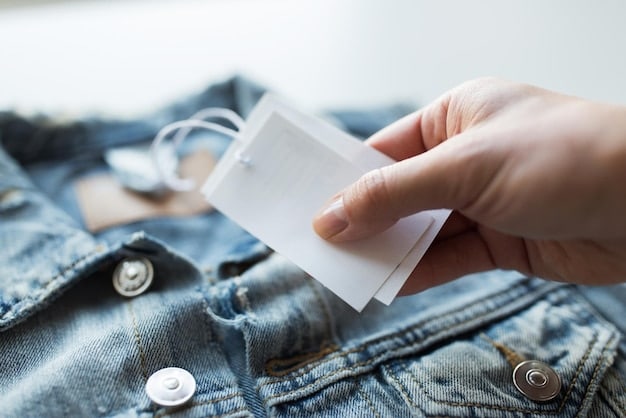Outlet Return Policies: Avoid Common Mistakes & Shop Smart

Navigating outlet return policies can be complex, but understanding the nuances and common pitfalls is crucial to avoid unwanted surprises and ensure a smooth shopping experience.
Shopping at outlets can feel like a treasure hunt, filled with exciting finds and incredible savings. However, the thrill can quickly fade if you need to return an item only to discover strict or confusing policies. That’s why understanding The Insider’s Guide to Outlet Return Policies: Avoid These Common Mistakes is not just helpful, it’s essential. This guide will equip you with the knowledge to shop smarter and return with confidence, ensuring your outlet adventures remain rewarding.
Understanding the Basics of Outlet Return Policies
Outlet stores, by their very nature, operate differently from traditional retail establishments. Their business model relies on moving merchandise quickly, often irregulars, past-season items, or inventory specifically made for outlets. This core difference profoundly impacts their return policies, which are frequently more restrictive than those found at a full-price retail counterpart.
Before making any purchase, assume outlet return policies differ significantly. They often have shorter return windows, stricter conditions regarding the item’s state, and specific rules about final sale items. It is imperative to familiarize yourself with these general principles to avoid disappointment down the line.
Key Differences from Standard Retail
Unlike department stores or brand boutiques that might offer generous 30-to-90-day return periods, outlet stores generally operate on a tighter timeline. You might find a 14-day or even a 7-day window. This reduced flexibility means you need to be prompt in your decision-making and inspection of purchases.
Another crucial distinction lies in the condition of items. While a full-price store might accept returns on lightly worn items, outlet stores are much stricter. The item must typically be in its original, unworn, and unwashed condition with all tags still attached. Some outlets even have specific policies for items with minor flaws already declared at the time of purchase, making them non-returnable.
- Shorter return windows (e.g., 7-14 days).
- Stricter condition requirements for returns.
- More frequent “final sale” designations.
- Potential differences in store credit vs. refund options.
It’s also common for outlet stores to have a more pronounced “final sale” section or specific items marked as such. These items are often deeply discounted, and the trade-off is that they cannot be returned or exchanged under any circumstances. Always double-check tags and ask staff if an item is final sale before you buy.
The Importance of the Original Receipt
While some traditional retailers might offer store credit for returns without a receipt, this is rarely the case at outlet stores. The original receipt is almost universally required for any return or exchange. Without it, your chances of a successful return drop dramatically, even if the tags are attached and the item is in perfect condition.
Additionally, the method of refund often ties directly to the original form of payment. If you paid with a credit card, the refund will typically be issued back to that card. If you paid with cash, you would receive cash back. Store credit might be an option if you don’t have the receipt, but it is entirely at the discretion of the particular store and not guaranteed.
In summary, understanding these fundamental differences is your first step toward becoming a savvy outlet shopper. Always assume more stringent rules, prioritize keeping your receipt, and clarify any doubts with store associates before leaving the premises.
Common Mistakes to Avoid When Returning Outlet Purchases
Even with the best intentions, shoppers frequently stumble when it comes to outlet returns. These common errors can lead to frustration, lost money, and a less enjoyable shopping experience. Being aware of these pitfalls is key to a smooth return process, saving you time and avoiding disappointment.
One of the most frequent errors is assuming uniformity in policies. Just because one brand’s outlet offers a certain return period doesn’t mean another brand, or even another store within the same brand’s outlet chain, will have the identical policy. Each store is an independent entity in terms of its return rules. Therefore, treating each purchase as unique in terms of its potential return requirements is a crucial mindset to adopt.
Mistake 1: Ignoring the Return Window
The swift passage of time is the enemy of many outlet returns. Unlike traditional retail, where a 30-day window is common, outlet stores often operate on a much tighter schedule. A typical outlet return window might be 7 or 14 days, with some even shorter for specific items or sales.
Failing to return an item within this specified period is perhaps the most common reason for denied returns. Life gets busy, and that outfit you bought on a whim might sit in your closet for weeks. By the time you decide it’s not right, the return window may have long closed. Always check the return policy immediately after purchase and make a mental note, or even set a reminder, for the last day an item can be returned.
- Always confirm the exact return period at the time of purchase.
- Set a calendar reminder for returns.
- Don’t procrastinate on returns; the clock starts ticking immediately.
Some outlets might have a grace period, but this is rare and not something to rely on. Once the stated return window has passed, the store is under no obligation to accept the item back, regardless of its condition or whether you have the original tags and receipt. This strict adherence to dates is a cornerstone of outlet retail.
Mistake 2: Discarding Tags and Receipts Prematurely
This mistake goes hand-in-hand with ignoring the return window and is equally detrimental. The original tags and receipt are your golden tickets for a return. Without them, even if you are within the return period and the item is unworn, your chances of a successful return are minimal to none.
Many shoppers remove tags as soon as they get home or toss receipts without a second thought. For outlet purchases, cultivate the habit of retaining all tags attached to the item and keeping receipts in a dedicated spot until you are absolutely certain you will not be returning the item. This applies even if you are sure about the purchase; circumstances can change.
Receipts, specifically, are crucial not just for proof of purchase but also for price verification and linking the purchase to the original form of payment. Some stores may deny returns or offer only store credit at the current selling price (which could be significantly lower than what you paid) if the original receipt is not presented. Always treat your receipt as valuable as the item itself.

Mistake 3: Misunderstanding “Final Sale” Items
The term “final sale” at an outlet store means exactly that: the sale is final. There are no returns, no exchanges, and no exceptions. These items are often deeply discounted to clear inventory and are explicitly marked as such. Common categories for final sale items include:
- Clearance or “red-tag” items.
- Swimwear, intimates, and sometimes accessories like earrings.
- Items purchased during specific promotional events or “doorbuster” sales.
- Damaged or irregular items sold with disclosed flaws.
A frequent error is assuming that “final sale” might have some wiggle room, especially if the item turns out to be defective. Unfortunately, unless otherwise stated by law (which is rare for disclosed flaws), final sale items remain non-returnable. Always verify if an item is final sale *before* you pay. If in doubt, ask a sales associate to clarify. A simple question can prevent a costly mistake and ensures you are fully aware of what you’re agreeing to purchase without the possibility of return.
Essential Tips for a Hassle-Free Outlet Return Experience
Navigating outlet returns successfully requires proactivity and attention to detail. By implementing a few key strategies, you can significantly increase your chances of a smooth and satisfactory return experience, saving yourself time, money, and unnecessary stress. These tips go beyond merely avoiding mistakes and empower you to handle any situation effectively.
Preparation is paramount. Imagine needing to return an item on a busy Saturday, only to realize you’ve lost the receipt or removed the tags. A little foresight can prevent these common frustrations. Think of your visit to the outlet and potential returns as a two-stage process, with the second stage (the return) needing as much consideration as the first (the purchase).
Tip 1: Always Ask About the Return Policy
Never assume. The moment you decide to purchase something, take a few extra seconds to clarify the store’s specific return policy. This is the single most effective way to avoid surprises. Ask simple, direct questions at the register:
- “What is your return policy for this item?”
- “What’s the return window?”
- “Do I need the original receipt and tags?”
- “Are there any final sale items here?”
Sales associates are trained to provide this information. If you’re buying multiple items from different stores, make a mental note or quickly jot down the return policy for each, especially if they differ significantly. This habit ensures you are always informed and can make decisions confidently about whether a purchase is worth the potential return hassle.
Tip 2: Keep All Original Packaging and Tags Intact
As mentioned, removed tags are a common reason for denied returns. It’s not enough to ensure the clothing itself is unworn; all original tags must still be attached as they were at the point of sale. This includes price tags, brand tags, and any specialty tags that might indicate materials or care instructions.
For items that come in boxes or with additional packaging (like shoes, handbags, or electronics), retaining this original packaging is equally important. Many stores require the item to be returned in its original, undamaged packaging. This is particularly true for items that are considered high-value or are presented in specific branded boxes. Treat the packaging as an extension of the product itself until you are absolutely certain you will keep the item.
Even if an item seems perfect for you, wear it around the house for an hour or two to ensure comfort and fit before removing any tags. This “wear test” period with tags still attached can save you a lot of grief if you discover an issue later.
Tip 3: Understand Store Credit vs. Refund Options
While a full refund to your original form of payment is usually the goal for a return, some outlet stores (especially without a receipt) might only offer store credit. Understand the implications of this. Store credit means you are essentially locked into purchasing something else from that specific store, which might not be ideal if you don’t find anything else you like.
Always verify the store’s policy regarding refunds versus store credit, particularly for items purchased without a promotional discount or during a special event. Some outlets differentiate between “regular” returns and returns of items bought during a sale, where only store credit might be offered. Being clear on these distinctions helps manage your expectations and financial planning.
Navigating Specific Product Return Challenges
While the general principles of outlet returns apply across the board, certain product categories present their own unique challenges. Understanding these nuances can save you from unexpected frustrations, especially when dealing with items that are frequently marked as final sale or have specific hygiene considerations. It’s not just about the store’s policy, but also the nature of the product itself.
Many of these specific challenges stem from health and safety regulations or the inherent difficulty in reselling a used item. Therefore, outlets often implement stricter policies for these categories to protect their business and their customers. Awareness of these product-specific rules is a sign of a truly savvy shopper.
Final Sale Items: Swimwear, Undergarments, Jewelry
These categories are almost universally non-returnable at most retailers, and outlet stores are no exception. For hygiene reasons, items such as swimwear (if the sanitary liner is removed), undergarments, and earrings are typically considered final sale. Once purchased, they cannot be returned or exchanged.
This policy is in place to protect public health and to maintain sanitary conditions. Stores cannot reasonably resell an item like a swimsuit or a pair of earrings if there’s any doubt about it having been worn by a previous customer. While some retailers might offer exceptions if tags are intact and specific conditions are met, it’s wise to assume these items are always final sale at an outlet.
When purchasing items from these categories, be extra diligent about sizing and fit. Try them on over your clothes if possible, or ensure you are entirely certain about the purchase before heading to the register, as there will likely be no recourse once the transaction is complete.
Electronics and Tech Gadgets from Outlet Stores
The return policies for electronics bought at outlet stores can be particularly complex and vary wildly. Outlets often sell refurbished electronics, open-box items, or older models. Their return windows are frequently much shorter (e.g., 7 days) and may involve restocking fees.
It’s crucial to understand the warranty situation as well. An item bought at an outlet might have a different warranty than a brand new one from a full-price store. Confirm if the item comes with a manufacturer’s warranty, a store warranty, or no warranty at all. For refurbished items, the warranty is often limited.
Additionally, be prepared for technical checks if you return an electronic item. Stores might need to verify the item’s functionality and ensure all components are present and accounted for. Always retain original packaging, manuals, and accessories, as these are often required for a successful return. Testing the item immediately upon purchase is highly recommended.

Irregulars, Seconds, and Damaged Goods
Outlet stores frequently carry “irregulars” or “seconds”—items with minor manufacturing flaws, slight damage, or imperfections. These items are sold at a reduced price precisely because of these defects. When you purchase such an item, you are typically accepting its condition “as is.”
It is vital to inspect these items thoroughly before buying. Sales associates should ideally point out any imperfections, but ultimately, it’s your responsibility to confirm them. Once you’ve purchased an irregular or second-quality item, it is almost always non-returnable based on those disclosed flaws. Returning it claiming a defect that was already present and factored into the price will likely be denied.
If an item has an *undisclosed* defect that was not apparent at the time of purchase and you discover it later, it might be possible to return it, but this would be at the discretion of the store manager and would require strong evidence of a prior fault. Always clarify the return policy for specific irregular items if you are unsure.
When and How to Escalate a Return Issue
Despite your best efforts to understand and follow return policies, sometimes a return situation doesn’t go as planned. It can be frustrating when a store associate denies a return you believe should be accepted. Knowing when and how to escalate an issue can be the difference between walking away empty-handed and successfully resolving the situation.
Keep in mind that while you have rights as a consumer, outlet stores also have clear policies they are designed to enforce. Escalation should always be approached calmly and respectfully, armed with facts and documentation. A confrontational approach rarely yields positive results.
Speaking to a Manager
If a sales associate denies your return and you believe there’s a misunderstanding or a valid exception, politely ask to speak with a manager. Managers often have more leeway and a broader understanding of store policies, as well as the authority to make exceptions in certain circumstances. When speaking to a manager:
- Remain calm and polite, even if you’re frustrated.
- Clearly and concisely explain your situation.
- Present all relevant documentation: receipt, item with tags, and any original packaging.
- Refer to the policy (if you read it) and explain why you believe your return fits the criteria.
- Avoid emotional appeals or raising your voice. Stick to the facts.
Sometimes, a manager might be able to offer a store credit instead of a refund, or a partial refund, as a compromise. Be open to these solutions if they are acceptable to you. Your goal is resolution, not necessarily winning an argument.
Consumer Rights and State Laws on Returns
While return policies are set by individual retailers, consumer protection laws at the state level can sometimes override or complement these policies, particularly regarding defective merchandise. However, it’s important to note that generally, there is no federal law mandating return policies, and most states don’t require retailers to accept returns unless an item is defective or misrepresented.
If an item is genuinely faulty or not fit for its intended purpose, even if it’s a final sale item, you might have recourse under state consumer protection laws. Keep documentation of the defect (photos, videos) and any communication with the store. If a resolution can’t be reached directly with the store, you can consider filing a complaint with your state’s Consumer Protection Agency or the Better Business Bureau (BBB).
These avenues are typically for significant issues or patterns of deceptive practices, not for simply disagreeing with a store’s standard return policy on a non-defective item. Always research your specific state’s laws if you feel a serious consumer right has been violated.
Document Everything
For any significant purchase, and especially if you anticipate a potential return, it’s wise to document key details. This includes keeping your receipt, noting the return policy verbally stated by the associate (and their name if possible), and taking photos of the item’s condition immediately after purchase, especially if it was an irregular.
If you have to escalate an issue, having a clear paper trail (or digital trail) can be invaluable. This documentation helps support your case and demonstrates that you have acted responsibly. It removes ambiguity and provides concrete evidence for your claim, making it harder for the store to dismiss your request without proper consideration.
Maximizing Your Outlet Shopping Experience Beyond Returns
A smart shopper isn’t just someone who knows how to make a return; it’s someone who makes informed decisions from the outset, minimizing the need for returns altogether. Beyond understanding policies, there are several strategies you can employ to make your outlet shopping more efficient, more enjoyable, and ultimately, more successful. These tips focus on proactive measures and a strategic approach to outlet visits.
Think of your outlet shopping trip as a mission. Just as you wouldn’t go grocery shopping without a list, approaching an outlet with a plan can transform a chaotic hunt into a fruitful endeavor. This preparation helps you avoid impulse buys that you might later regret and ensures that your purchases truly add value to your wardrobe or home.
Do Your Research Before You Go
Before stepping foot in an outlet mall, do some preliminary research. Check the websites of the specific brands you’re interested in. Many brands list their outlet store locations and sometimes even current promotions or specific outlet-only items. Look for information on:
- Store Hours: Optimal times to visit to avoid crowds.
- Current Sales/Promotions: This can save you even more money.
- Specific Item Availability: While not always precise for outlets, some might hint at what’s in stock.
- General Return Policies: Some brand websites might offer a summarized return policy for their outlet locations.
Knowing what you’re looking for, and where to find it, can save valuable time and prevent aimless wandering, which often leads to impulse purchases. Create a list of desired items or brands, and prioritize them.
Inspect Items Thoroughly Before Purchase
This cannot be stressed enough, especially at an outlet. Deep discounts can be alluring, but they often come with caveats. Before taking any item to the register, perform a meticulous inspection:
- Check for Flaws: Look for stains, snags, tears, missing buttons, or broken zippers. This is especially important for “irregular” items.
- Examine Stitching: Poor stitching can indicate low quality or an item specifically made for the outlet with lower standards.
- Verify Sizing: Try items on if possible, as outlet sizing can sometimes differ slightly. Don’t rely solely on the tag.
- Test Functionality: For electronics or mechanical items, ensure they power on and basic functions work.
Don’t be afraid to take your time. A careful inspection upfront can prevent the need for a return later. If you find a minor flaw that you’re comfortable with, and it’s heavily discounted because of it, clarify with the sales associate if it’s considered “final sale” due to that specific defect.
Understand Outlet-Specific Merchandise
It’s a common misconception that outlet stores sell overstock from their full-price counterparts. While some do, a significant portion of outlet inventory is often “made for outlet” (MFO) merchandise. These items are designed and manufactured specifically for outlet stores, often using different materials, construction, or designs, which may result in a lower price point but also potentially lower quality compared to the brand’s full-price retail line.
Recognizing MFO items can help manage your expectations about quality and durability. While MFO items can still be great buys, understanding this distinction means you’re buying them for what they are, not assuming they are a discontinued full-price item. Look for subtle differences in tags (sometimes an extra dot or different interior tag), fabric composition, or construction details that might indicate an MFO garment.
By conducting thorough research, inspecting items carefully, and understanding the nature of outlet merchandise, you can significantly enhance your shopping success and reduce the likelihood of needing to deal with return policies in the first place.
| Key Point | Brief Description |
|---|---|
| ⏰ Time Limits | Outlet return windows are often much shorter (7-14 days). Check immediately! |
| 🏷️ Keep Tags & Receipts | Essential for most returns; without them, success is highly unlikely. |
| 🚫 “Final Sale” Means Final | Swimwear, intimates, deeply discounted items are typically non-returnable. Verify upfront. |
| ❓ Ask Before You Buy | Always confirm a store’s specific return policy at checkout to avoid surprises. |
Frequently Asked Questions About Outlet Returns
▼
No, typically outlet store return policies are more stringent than those of regular retail stores. They often feature shorter return windows, stricter conditions for item returns (e.g., all original tags must be attached and item unworn), and a higher prevalence of “final sale” items. Always confirm the specific policy at the outlet store where you make a purchase.
▼
“Final sale” items are products that cannot be returned or exchanged under any circumstances. This often includes swimwear, undergarments, earrings, heavily discounted clearance items, or merchandise sold “as is” with disclosed flaws. It’s crucial to confirm if an item is final sale before you complete the purchase, as there are generally no exceptions once bought.
▼
While some traditional retailers might offer store credit for returns without a receipt, it is highly unlikely at most outlet stores. The original receipt is almost always a mandatory requirement for any return or exchange at an outlet. Without it, your return request will likely be denied, or at best, you might be offered store credit at the current lowest selling price, which could be less than you paid.
▼
“Made for outlet” (MFO) merchandise refers to items specifically designed and manufactured for outlet stores, which might differ in quality or materials from full-price retail versions. While MFO status doesn’t directly change a store’s return policy, understanding that these items are distinct can manage expectations. Returns are still subject to the store’s standard policy for MFO items, just like any other merchandise sold there.
▼
If your return is denied and you believe you meet all policy requirements, politely ask to speak with a manager. Clearly and calmly explain your situation, detailing how you adhere to their policy, and present all your documentation, such as the original receipt and the item with tags. Most issues can be resolved at this level. If not, research your state’s consumer protection laws for further steps, especially if the item is defective.
Conclusion
Navigating the world of outlet shopping can be incredibly rewarding, offering access to desired brands at lower price points. However, the key to truly maximizing these adventures—and avoiding frustrating pitfalls—lies in a clear understanding of return policies. By diligently checking return windows, safeguarding your receipts and tags, understanding “final sale” designations, and proactively asking questions, you equip yourself to shop smarter and return with confidence. These simple, yet crucial, practices not only save you potential headaches but also enhance your overall outlet shopping experience, ensuring that every purchase, whether it stays or goes, is a positive one.





